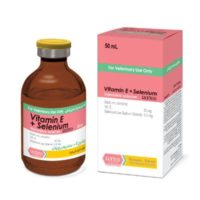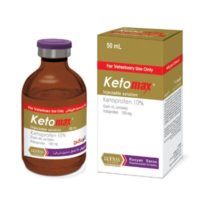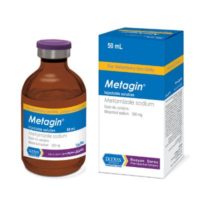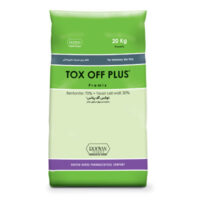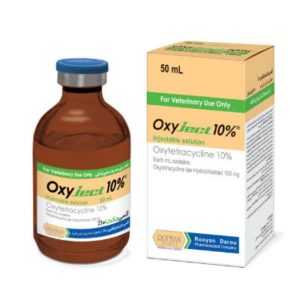
- - animals:
- - type:
- antibiotics
- - usage:
- injectable sterile solution
- - manufacturer:
- Rooyan Darou
- - Packaging:
- 50 & 100 ml vials
Product properties
Composition
Each ml contains 100 mg Oxytertracycline hydrochloride
Mechanism of Action:
Oxytetracycline is produced by streptomyces rimosus. Oxytetracycline prevents attachment of aminoacyl transfer ribonucleic acid (aa-tRNA) to 30s unit of ribosome resulted in inhibition of protein synthesis in growing bacteria. In other hand this drug causes reduction of conversion of glutamate to cellular protein, consequently decreasing bacterial growth. Probably Oxytetracycline affects on ribosomal 50s unit and changes permeability in susceptible bacteria. Oxytetracycline effective plasma concentration is achieved 15 minutes after intramuscular injection and reaches to peak level after one hour. Blood concentration remains about 12 hours and gradually reduced 24 hours after injection. Diffusion of this drug is very wide in the body. After absorption, Oxytetracyline can be found in heart, kidneys, lungs, muscles, pleural fluid, lung secretions, bile, saliva, urine and synovial fluid. Diffusion of this drug in CSF is low but it passes from placenta easily. Diffusion volume in cow is 0.8 L/kg , in horse is 4.1 L/kg and in small animals is 1.2 L/kg. Rate of attachment of this drug to plasma protein is 10-40 percent. Oxytetracycline is excreted via kidney without any change. Therefore it can be used in treatment of urinary infections. Oxytetracycline is not metabolized and enters into digestive system via bile and chelated with some substances in faeces.
Indications of use
Oxytetracycline is a broad spectrum antibiotic that affects on many of Gram positive and Gram negative bacteria. In general, it affects Mycoplasma spp., Spirochaetes (like lyme disease agent), Chlamydia and Rickettsia. Oxytetracycline is effective on some strains of Staphylococcus and Streptococcus. Gram positive bacteria which are sensitive to tetracyclines including Actinomyces, Bacillus anthracis, Clostridium perfringens, Clostridium tetani, Listeria monocytogenes and Nocardia. Some Gram negative bacteria which are sensitive to Oxytetracycline including Bordetella, Brucella, Bartonella, Haemophilus, Pasteurella multocida, Shigella and Yersinia pestis. Generally this drug is used for following diseases:
Cattle, sheep and goats:
Urogenital infections: metritis, mastitis, pyelonephritis, cystitis, retained placenta and its following infections.
Respiratory infections: pneumonia, pleurisy and shipping fever.
Other infectious diseases such as anaplasmosis, agalactia, leptospirosis, salmonellosis, brucellosis, anthrax, enterotoxemia, foot rot, actinomycosis, actinobacillosis, and postoperative infections.
Horse: Articular infections (polyarthritis) like lyme disease, strangel, enteritis and pneumonia
Dosage and route of administration
This drug is used through intramuscular, intravenous and subcutaneous route. In toxemia cases, intravenous injection can decrease shock probability. intravenous injection is done just once a day and in acute cases twice a day. Suggested dose is 5-10 mg/kg body weight for 4-5 days. (2-5 ml for each 45 kg body weight).
Withdrawal Time
Meat:14 days
Milk :5 days
Drug interactions:
Do not use simultaneously with penicillin.
Precautions
This drug should not be used in sensitive animals to Oxytetracyclines. Do not use in animals with hepatic and renal failure. Intramuscular injection must be done slowly and next injection should be done in other site. Avoid injection in one site more than 10 ml. Intra spinal injection of this drug is very dangerous but in acute cases it is possible cautiously. Because of effect of this drug on fetus (preventing from skeletal growth and formation of yellow and colorless teeth), it can be used only in second half of pregnancy with a great caution. Long-term use of this drug in young animals can be resulted in changing color of bone and teeth to brown, yellow and gray. It is possible to appear local reaction and necrosis in injection site. Rapid intravascular injection causes arrhythmia and collapse that its reason is attachment to blood calcium ion.
Storage conditions
Keep below 30º C and away from direct light.


